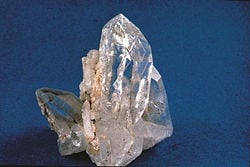Solid

A solid is one of the four principal states of matter. A solid object is characterized by resistance to deformation and change of volume. The branch of physics that deals with solids is called solid-state physics, and it is a type of condensed matter physics. Materials science is primarily concerned with properties of solids such as strength and phase transformations. It overlaps strongly with solid-state physics. Solid-state chemistry overlaps both these fields, but it is especially concerned with the synthesis of novel materials.
Properties
On the level of atoms and molecules, a solid has these properties :
- The atoms or molecules that comprise the solid are packed closely together. These constituent elements have fixed positions in space relative to each other. This accounts for the solid's rigidity.
- If there is long-range order or repeating pattern in the positions of the atoms or molecules of a solid, it is called a crystalline solid. A crystal structure is composed of a unit cell, (a set of atoms arranged in a particular way), which is periodically repeated in three dimensions on a lattice. A crystal's structure and symmetry play a role in determining many of its properties, such as cleavage, electronic band structure, and optical properties. If sufficient force is applied, the ordered structure can be distorted, causing permanent deformation.
- If there is no long-range order or repeating pattern in the positions of the atoms or molecules of a solid, it is called an amorphous solid. Examples of amorphous solids include window glass, many polymers (such as polystyrene), and foods such as cotton candy.
- Because any solid has some thermal energy, its atoms vibrate. However, this movement is very small, and cannot be observed or felt under ordinary conditions.
- Most solids, when heated, are converted to the liquid form at their respective melting points. Some solids, however, are converted directly to the gaseous formâa property known as sublimation.
The lightest known solid is man-made and is called aerogel. The lightest aerogel produced has a density of 1.9 mg/cm3 or 1.9 kg/m3 (1/530 as dense as water).
Measurement
Quantities of solids are commonly measured in units of mass and volume. Units of mass include grams, kilograms (an SI unit), and pounds; units of volume include the cubic meter (m³) (an SI unit).
See also
- Gas
- Liquid
- Melting point
- Plasma (matter)
- Sublimation
ReferencesISBN links support NWE through referral fees
- Ashcroft, Neil W., N. David Mermin. 1976. Solid State Physics. New York, NY: Holt, Rinehart and Winston. ISBN 0030839939
- Grosso, Giuseppe, and Giuseppe Pastori Parravicini. 2000. Solid State Physics. San Diego, CA: Academic Press. ISBN 012304460X
- Kittel, Charles. 2004. Introduction to Solid State Physics. Hoboken, NJ: Wiley. ISBN 047141526X
| States of Matter |
|---|
| Solid | Liquid | Gas | Plasma | Colloid | Supercritical fluid | Superfluid | Supersolid | Degenerate matter | Quark-gluon plasma | Fermionic condensate | BoseâEinstein condensate | Strange matter | Melting point | Boiling point | Triple point | Critical point | Equation of state | Cooling curve |
Credits
New World Encyclopedia writers and editors rewrote and completed the Wikipedia article in accordance with New World Encyclopedia standards. This article abides by terms of the Creative Commons CC-by-sa 3.0 License (CC-by-sa), which may be used and disseminated with proper attribution. Credit is due under the terms of this license that can reference both the New World Encyclopedia contributors and the selfless volunteer contributors of the Wikimedia Foundation. To cite this article click here for a list of acceptable citing formats.The history of earlier contributions by wikipedians is accessible to researchers here:
The history of this article since it was imported to New World Encyclopedia:
Note: Some restrictions may apply to use of individual images which are separately licensed.